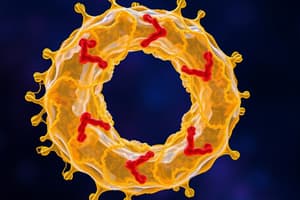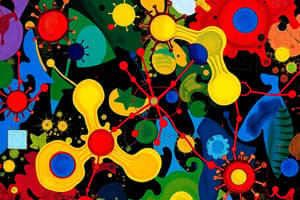Podcast
Questions and Answers
What cellular event MUST occur before a cell can proceed into M phase?
What cellular event MUST occur before a cell can proceed into M phase?
- Replication of the Golgi apparatus.
- Formation of the cleavage furrow.
- Duplication of both centrosomes and chromosomes. (correct)
- Synthesis of new endoplasmic reticulum.
In eukaryotic cells, the duration of the cell cycle can vary significantly depending on cell type. Which phase exhibits the most variability in length?
In eukaryotic cells, the duration of the cell cycle can vary significantly depending on cell type. Which phase exhibits the most variability in length?
- G2 phase
- S phase
- M phase
- G1 phase (correct)
What would be the MOST likely outcome of adding colchicine to cells poised to transition from metaphase to anaphase?
What would be the MOST likely outcome of adding colchicine to cells poised to transition from metaphase to anaphase?
- The chromosomes would segregate and the cell would elongate normally.
- The cell would elongate, but the chromosomes would fail to segregate.
- The chromosomes would segregate, but the cell would NOT elongate properly. (correct)
- Both chromosome segregation and cell elongation would proceed normally.
How do mitotic Cdk levels and cyclin concentrations change during the cell cycle?
How do mitotic Cdk levels and cyclin concentrations change during the cell cycle?
You fuse an early G1 phase cell with an S phase cell. What is the MOST likely outcome?
You fuse an early G1 phase cell with an S phase cell. What is the MOST likely outcome?
What does 'generation time' refer to in the context of cell division?
What does 'generation time' refer to in the context of cell division?
During mitosis, kinetochores play a vital role in chromosome segregation. When do kinetochores assemble onto chromosomes and what specifically do kinetochore microtubules attach to?
During mitosis, kinetochores play a vital role in chromosome segregation. When do kinetochores assemble onto chromosomes and what specifically do kinetochore microtubules attach to?
Why is cyclin binding to Cdk essential for cell cycle progression?
Why is cyclin binding to Cdk essential for cell cycle progression?
What is the MOST likely consequence of underexpression of Mad or Bub proteins in a cell?
What is the MOST likely consequence of underexpression of Mad or Bub proteins in a cell?
What dynamic process is masked by the apparent inactivity of the spindle and sister chromatids during metaphase?
What dynamic process is masked by the apparent inactivity of the spindle and sister chromatids during metaphase?
Which of the following is NOT an activity associated with microtubule motor proteins during mitosis?
Which of the following is NOT an activity associated with microtubule motor proteins during mitosis?
A cell lacking a protein required for a G2 checkpoint mechanism would MOST likely exhibit:
A cell lacking a protein required for a G2 checkpoint mechanism would MOST likely exhibit:
How do cyclins regulate the progression of cells through the cell cycle?
How do cyclins regulate the progression of cells through the cell cycle?
Which of the following statements is TRUE regarding the regulation of Cdk activity during the cell cycle?
Which of the following statements is TRUE regarding the regulation of Cdk activity during the cell cycle?
What would MOST likely happen if the Rb protein were mutated such that it could NOT be phosphorylated by cyclin-dependent kinases?
What would MOST likely happen if the Rb protein were mutated such that it could NOT be phosphorylated by cyclin-dependent kinases?
What key cellular process is assessed at the eukaryotic cell G2-M checkpoint?
What key cellular process is assessed at the eukaryotic cell G2-M checkpoint?
What event triggers the decrease in mitotic cyclin (M cyclin) concentration towards the end of M phase?
What event triggers the decrease in mitotic cyclin (M cyclin) concentration towards the end of M phase?
What is the direct role of condensin phosphorylation in chromosome dynamics?
What is the direct role of condensin phosphorylation in chromosome dynamics?
What protein complex holds sister chromatids together after DNA replication?
What protein complex holds sister chromatids together after DNA replication?
What would MOST likely happen if a chemical that depolymerizes microtubules were added to cells during mitosis?
What would MOST likely happen if a chemical that depolymerizes microtubules were added to cells during mitosis?
How does the retinoblastoma (Rb) protein block cells from entering the cell cycle?
How does the retinoblastoma (Rb) protein block cells from entering the cell cycle?
Which event is directly involved in the G1 DNA damage checkpoint?
Which event is directly involved in the G1 DNA damage checkpoint?
What is the correct order of kinases in the MAPK signaling pathway?
What is the correct order of kinases in the MAPK signaling pathway?
Which family of proteins plays a central role in regulating the assembly and activation of the contractile ring during cytokinesis?
Which family of proteins plays a central role in regulating the assembly and activation of the contractile ring during cytokinesis?
What is the correct order of events in the pathway by which activation of PI3-kinase stimulates cell division?
What is the correct order of events in the pathway by which activation of PI3-kinase stimulates cell division?
What is the order of events in irradiated mammalian cells that leads to cell cycle arrest at the G1 checkpoint?
What is the order of events in irradiated mammalian cells that leads to cell cycle arrest at the G1 checkpoint?
Which of the following cellular components does NOT participate in apoptosis?
Which of the following cellular components does NOT participate in apoptosis?
Which of the following processes does NOT typically involve apoptosis?
Which of the following processes does NOT typically involve apoptosis?
Flashcards
Centrosome & Chromosome Duplication
Centrosome & Chromosome Duplication
Duplicated before a cell enters M phase.
Cell Growth During G2 phase
Cell Growth During G2 phase
Cells do most of their growing.
Generation time
Generation time
The time it takes for a cell to progress through a complete cell cycle.
Kinetochore Assembly
Kinetochore Assembly
Signup and view all the flashcards
Cyclin Binding to Cdk
Cyclin Binding to Cdk
Signup and view all the flashcards
Metaphase Tension
Metaphase Tension
Signup and view all the flashcards
Activities of Microtubule Motor Proteins during Mitosis
Activities of Microtubule Motor Proteins during Mitosis
Signup and view all the flashcards
Cyclin's Role
Cyclin's Role
Signup and view all the flashcards
Cdk Activity Regulation
Cdk Activity Regulation
Signup and view all the flashcards
Rb Protein Mutation Effect
Rb Protein Mutation Effect
Signup and view all the flashcards
Eukaryotic Cell G2-M Checkpoint
Eukaryotic Cell G2-M Checkpoint
Signup and view all the flashcards
Mitotic Cyclin (M cyclin) decrease
Mitotic Cyclin (M cyclin) decrease
Signup and view all the flashcards
Condensin Phosphorylation
Condensin Phosphorylation
Signup and view all the flashcards
Sister Chromatid Linkage
Sister Chromatid Linkage
Signup and view all the flashcards
Microtubule Depolymerization During Mitosis
Microtubule Depolymerization During Mitosis
Signup and view all the flashcards
Retinoblastoma (Rb) Protein Function
Retinoblastoma (Rb) Protein Function
Signup and view all the flashcards
G1 DNA Damage Checkpoint
G1 DNA Damage Checkpoint
Signup and view all the flashcards
Rho protein families
Rho protein families
Signup and view all the flashcards
PI3-Kinase Pathway
PI3-Kinase Pathway
Signup and view all the flashcards
Irradiated Mammalian Cells
Irradiated Mammalian Cells
Signup and view all the flashcards
Examples of Apoptosis
Examples of Apoptosis
Signup and view all the flashcards
Apoptosis Promotion
Apoptosis Promotion
Signup and view all the flashcards
Roles in Apoptosis
Roles in Apoptosis
Signup and view all the flashcards
Hormone Signaling
Hormone Signaling
Signup and view all the flashcards
Paracrine Signaling
Paracrine Signaling
Signup and view all the flashcards
Kinases and Phosphatases
Kinases and Phosphatases
Signup and view all the flashcards
Hydrophilic Signal Molecules
Hydrophilic Signal Molecules
Signup and view all the flashcards
Protein Kinases
Protein Kinases
Signup and view all the flashcards
G Protein Activation
G Protein Activation
Signup and view all the flashcards
G Protein Signal Length
G Protein Signal Length
Signup and view all the flashcards
Study Notes
- Before a cell enters M phase, centrosomes and chromosomes must undergo duplication.
- Cell growth predominantly occurs during the G2 phase of the cell cycle.
- The time to complete a cell cycle varies among eukaryotic cells, with stage variations depending on cell type; for example, rapidly dividing embryonic cells may eliminate the G1 phase.
- Adding colchicine at the metaphase-anaphase transition results in chromosome segregation without cell elongation due to microtubule disruption.
- Mitotic Cdk is present throughout all cell cycle phases, whereas cyclin concentrations fluctuate.
- Fusing early G1 phase cells with S-phase cells triggers DNA replication in the G1 cells.
- Generation time is the time it takes a cell to complete one cell cycle.
- Kinetochores assemble on chromosome centromeres during late prophase, and kinetochore microtubules attach to kinetochores.
- Cyclin binding to Cdk is essential for Cdk's enzymatic activity, enabling cell cycle progression.
- Under-expression of Mad or Bub proteins can lead to premature APC activation, causing chromatid separation and potential non-disjunction.
- At metaphase, sister chromatids are actively pulled toward opposite poles, despite the appearance of inactivity.
- Microtubule motor proteins function during mitosis to shorten kinetochore microtubules, pull them in at centrosomes, push interpolar microtubules for anaphase, and pull astral microtubules toward the cell cortex.
- A cell lacking a G2 checkpoint protein will enter M phase inappropriately.
- Cyclins regulate cell cycle progression by activating protein kinases.
- Cdk activity changes due to fluctuating cyclin levels, not Cdk synthesis or degradation.
- If the Rb protein cannot be phosphorylated, the cell will not enter S phase.
- The G2-M checkpoint assesses DNA replication status.
- Mitotic Cdk-cyclin is active when singly phosphorylated.
- The anaphase-promoting complex (APC) is not continuously active throughout the cell cycle.
- Mitotic cyclin (M cyclin) concentration decreases due to ubiquitylation and degradation at the end of M phase.
- Phosphorylation of condensin is essential for chromosome condensation.
- Cohesins hold sister chromatids together after DNA replication.
- Microtubule depolymerization during mitosis prevents chromosome alignment in metaphase.
- The Retinoblastoma (Rb) protein inhibits cyclin transcription, blocking cell entry into the cell cycle.
- The G1 DNA damage checkpoint inhibits cyclin–Cdk complexes via p21.
- The relationship of Raf to MEK mirrors that of MEK to MAPK.
- Rho proteins regulate the assembly and activation of the contractile ring for cytokinesis.
- CENP-A is not involved in DNA replication licensing during S phase.
- The PI3-kinase activation pathway for cell division proceeds as: PIP3 formation, Akt phosphorylation, and TOR activation.
- Irradiated mammalian cells halt at the G1 checkpoint in the order: DNA damage, p53 accumulation and activation, p21 production, and cyclin–Cdk complex inhibition.
- Cytotoxic lymphocytes can trigger self-destruction in target cells via Death Receptor interaction.
- Apoptosis involves caspases, death signals, mitochondria, and Bcl-2, but not APC ubiquitin ligase activity.
- Apoptosis is involved in digit webbing removal, neuron reduction during brain development, pathogen-infected cell destruction, and white blood cell removal at life's end, but not cancer tumor generation.
- Necrosis involves cell rupture, unlike apoptosis.
- Apoptosis is promoted by cytochrome c release from mitochondria into the cytosol.
Protein Roles
- Bcl-2 is involved in apoptosis.
- p53 directly regulates cell cycle processes.
- Ras is involved in mitogen signaling pathways.
- Securin is important for chromosome separation and cytokinesis.
- APC is also involved in chromosome separation and cytokinesis.
- MAPK is a component of mitogen signaling pathways.
- Cdk directly regulates cell cycle processes.
- Cytochrome c promotes apoptosis.
- Hormones are suited for sending signals to most cells throughout a multicellular organism.
- Regulation of inflammatory responses at an infection site is an example of paracrine signaling.
- Kinases and phosphatases turn proteins "on and off" via phosphorylation status.
- Hydrophilic extracellular signal molecules require cell-surface receptors to signal target cells.
- Protein kinases transfer a terminal phosphate from ATP to a protein; serine/threonine kinases are common types of protein kinases; GTP-binding proteins exchange GDP for GTP to activate and a GAP is used instead of a phosphatase to help the molecular switch to hydrolyze GTP.
- G-protein-coupled receptors activate G proteins, causing the α subunit to exchange GDP for GTP.
- The duration of G protein signaling is determined by the GTPase activity of Gα.
G Protein Targets and Outcomes
- Adenylyl cyclase leads to increased cAMP levels.
- Ion channels lead to changes in membrane potential.
- Phospholipase C leads to cleavage of inositol phospholipids.
- The steps in the EGF–cAMP signaling pathway are: ligand binding, G-protein activation, adenylyl cyclase activation, cAMP production, and protein kinase A activation.
- cAMP interacts directly with protein kinase A regulatory subunits.
- IP3 receptors, associated with ER membranes, aid in calcium release.
- A protein kinase acts as an integrating device if activated by proteins in different signaling pathways.
- Dephosphorylation by serine/threonine phosphatases is not directly involved in inactivating an activated RTK.
- Ras does not bind steroid hormones.
- Akt promotes cell survival by affecting Bad and Bcl2; in the absence of a survival signal, Bad is not phosphorylated.
- Autophosphorylation in receptor tyrosine kinases provides recruitment sites for signal transduction molecules.
- If Ras GTPase activity is abolished, MAP kinases are continuously activated, promoting continuous mitotic divisions.
- Terminally differentiated cells can no longer divide.
- Terminally differentiated cells are replaced by proliferating precursor cells.
- A stem cell divides into a terminally differentiated cell and a stem cell.
- Malignant tumors are more dangerous due to their ability to invade other tissues.
- A mutation introducing a stop codon after the initiator methionine cannot convert a proto-oncogene into an oncogene.
- Growth in liquid medium is an immediate consequence of anchorage-independent cancer cell growth.
- Alterations that could cause increased cell proliferation include an alteration of a protein that normally promotes apoptosis and alteration of a protein that normally prevents progress through the cell cycle if there is something defective about the cell.
- Tumor suppressor gene absence promotes cancer, while oncogene presence promotes cancer.
- Cells with one functional copy of a tumor suppressor gene usually do not proliferate faster than normal cells.
- Density-dependent inhibition of growth does not contribute to cancer cell proliferation.
- Cancer cells generally divide at the same rate as normal cells.
- Oncogene expression contributes to cancer development.
- Cancer cell aneuploidy is likely caused by a Mad defect.
- Histone methylation is not a mechanism by which proto-oncogenes are converted to oncogenes.
- Hereditary breast and ovarian cancer often arises from a mutant copy of BRCA1 or BRCA2, involved in DNA double-strand break repair.
- A physician would not expect to find perfectly spherical nuclei when examining suspect cells in biopsy tissue
- Cancer screening procedures include pap smears, mammography, Sept 9 expression levels, and colonoscopies.
Studying That Suits You
Use AI to generate personalized quizzes and flashcards to suit your learning preferences.



